
Introduction
In today's technologically advanced world, the demand for efficient, reliable, and compact pumping solutions is greater than ever. This is where miniature diaphragm pumps for air and gas come into play, serving as critical components across a variety of industries including medical, environmental, and industrial applications. These pumps have revolutionized fluid and gas transfer, offering unparalleled advantages in terms of size, power consumption, and versatility.
Miniature diaphragm pumps operate on simple yet effective principles, allowing them to move air or gas from one place to another with high efficiency. Often made from durable materials like PPS (Polyphenylene sulfide) or EPDM (Ethylene Propylene Diene Monomer rubber), these pumps are not only robust but also capable of operating under harsh conditions. Their small footprint makes them especially suitable for applications where space is at a premium.
This article aims to provide a comprehensive guide on miniature diaphragm pumps for air and gas. We'll delve into their key features and specifications, covering aspects such as design, construction, efficiency, and performance. Furthermore, we'll explore the diverse range of industry applications these pumps are found in, from healthcare and environmental monitoring to chemical processing and beyond. To assist potential buyers, a buying guide will also be included, focusing on the critical factors to consider and the top brands to look out for in the market.
By the end of this article, you'll have an in-depth understanding of why miniature diaphragm pumps are indispensable in modern applications and how to go about selecting the right one for your specific needs.
Stay tuned as we embark on this informative journey through the world of miniature diaphragm pumps for air and gas.
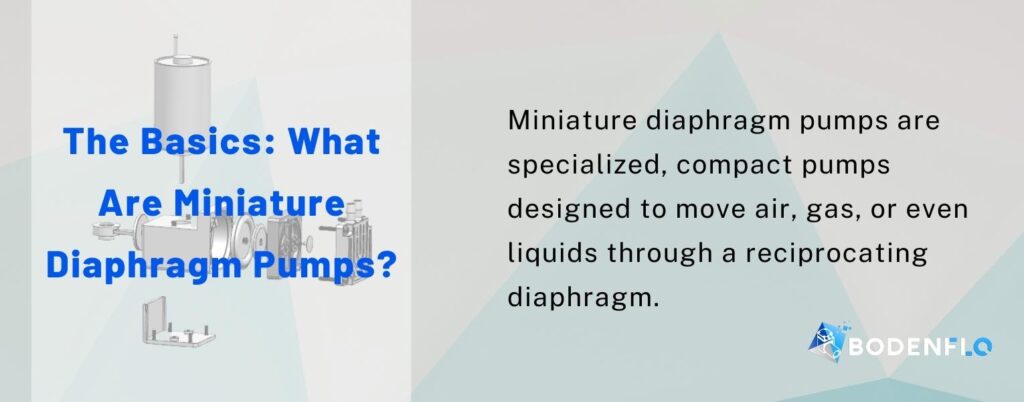
The Basics: What Are Miniature Diaphragm Pumps?
Miniature diaphragm pumps are specialized, compact pumps designed to move air, gas, or even liquids through a reciprocating diaphragm. The defining feature of these pumps is their diaphragm—a flexible, elastomeric or rubber membrane—that oscillates back and forth, creating a pressure differential that either draws in or expels the medium. In essence, the diaphragm replaces traditional pumping components like impellers or gears, enabling a simpler, more compact, and often more reliable system.
The term "miniature" underscores the pump's small size and lightweight characteristics. Despite their minimal footprint, these pumps are known for their performance capabilities. They are often engineered to meet strict specifications, including low power consumption, high efficiency, and resistance to corrosion or chemical exposure.
Primary Functions in Air and Gas Management
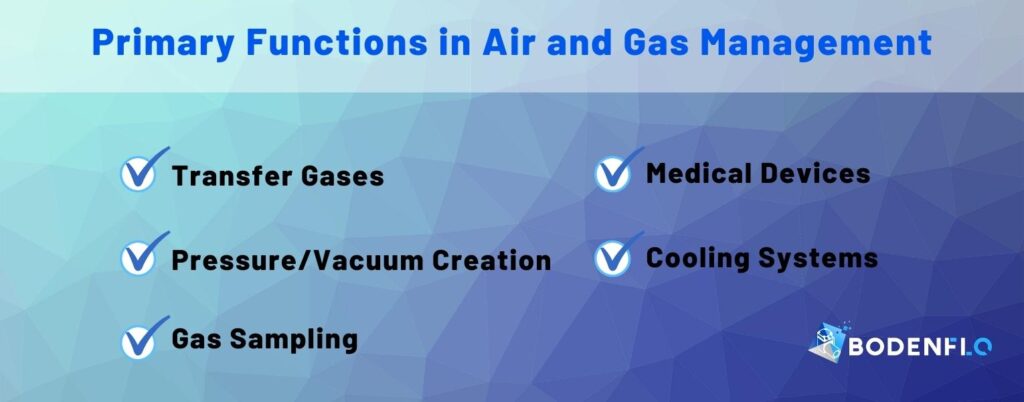
Miniature diaphragm pumps play a critical role in air and gas management applications, where they primarily serve to:
- Transfer Gases: One of the most straightforward uses of these pumps is in the transfer of gases from one location to another. This can range from pumping air for ventilation systems to transferring specialized gases in scientific research settings.
- Pressure/Vacuum Creation: These pumps can create a vacuum or positive pressure environment depending on their configuration, making them ideal for applications like vacuum packaging or pressure-driven filtration systems.
- Gas Sampling: In environmental or industrial settings, accurate sampling of gases is essential for monitoring air quality, detecting leaks, or measuring concentrations of specific compounds. These pumps facilitate precise, reliable sampling.
- Medical Devices: In medical applications, these pumps often act as the "heart" of devices like respirators, anesthesia machines, and Negative Pressure Wound Therapy (NPWT) devices, where the control and reliability of air and gas flow are critical.
- Cooling Systems: In some applications, miniature diaphragm pumps serve to circulate coolants or refrigerants, assisting in the thermal management of machinery or electronics.
Their capabilities extend far beyond simple fluid transfer. Their precision, controllability, and often, their ability to handle corrosive or particulate-laden media, make them indispensable in various sectors.
Understanding the functionality and advantages of miniature diaphragm pumps is key to recognizing their significance in today's increasingly complex and specialized technological landscape. Their applications are as diverse as they are crucial, marking these pumps as essential players in modern air and gas management systems.
Key Features of Miniature Diaphragm Pumps
When it comes to selecting a miniature diaphragm pump for your specific needs, several key features come into play. These attributes not only define the pump's operational capabilities but also its long-term durability and overall performance. Here are some of the crucial characteristics to consider:
Material
- Diaphragm Material: The diaphragm itself can be made from various materials like PTFE, EPDM, FKM, or Viton, depending on the application. For instance, chemical-resistant materials like PTFE are essential for handling aggressive or corrosive substances.
- Pump Housing: The outer shell is usually made from robust materials such as stainless steel, aluminum, or engineered plastics to endure various environmental conditions.
Durability
- Corrosion Resistance: As these pumps often handle harsh substances or operate in challenging environments, corrosion resistance is a vital feature.
- Wear and Tear: Look for pumps with a proven track record of minimal wear over extended use, as this will reduce long-term maintenance costs.
- Heat Resistance: In applications where temperature varies, it's crucial that the pump materials and internal electronics can withstand thermal fluctuations.
Efficiency
- Power Consumption: One of the main advantages of miniature diaphragm pumps is their low power consumption, which is particularly beneficial for battery-powered or energy-sensitive applications.
- Flow Rate & Pressure: Efficiency is also determined by the pump's ability to maintain a consistent flow rate and pressure. Modern pumps often come with variable speed settings to optimize efficiency.
- Noise Level: In environments like medical facilities or laboratories, a low noise output is crucial. Efficient design minimizes sound emissions.
Additional Features
- Controllability: Many high-end models offer advanced control features like programmable flow rates or pressure settings, and some even come with IoT integration for remote monitoring.
- Sealing Options: Depending on the application, you may require additional sealing features to prevent leakage or cross-contamination.
- Certifications: Look for pumps that have been tested and certified according to industry standards, whether it's ISO certifications for quality management or specific FDA approvals for medical use.
- Compact Design: The 'miniature' in their name isn't just for show; their compact size allows these pumps to be integrated into systems where space is a premium.
Understanding these key features will enable you to make an informed decision when selecting a miniature diaphragm pump, ensuring that you choose a product well-suited for your specific application needs.
Applications of Miniature Diaphragm Pumps in Air & Gas Systems
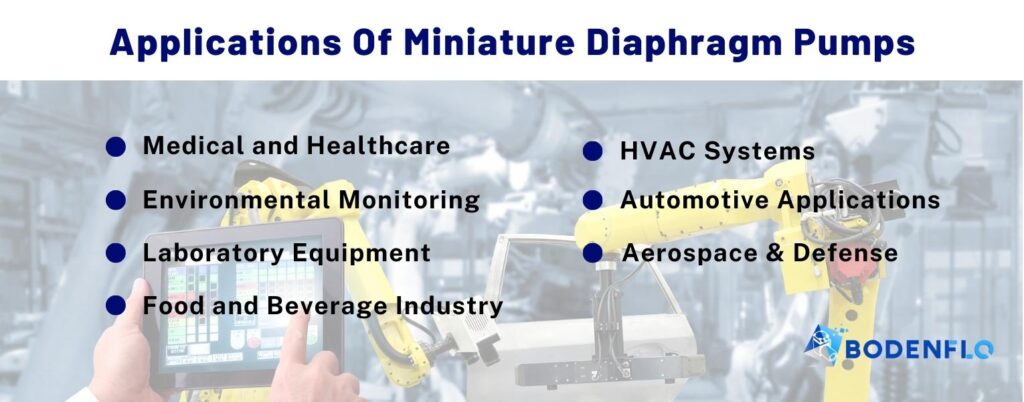
The versatility and efficiency of miniature diaphragm pumps make them indispensable tools across a wide array of industries. Their application is not merely limited to transferring fluids; they also play a crucial role in air and gas management systems. Here’s a look at some of the sectors where these pumps have made a substantial impact.
Medical and Healthcare
In medical devices such as ventilators, respiratory machines, and anesthesia systems, miniature diaphragm pumps are used to control airflow precisely. Their high efficiency and low power consumption make them ideal for portable medical devices, often being integral in life-saving applications.
Environmental Monitoring
Air sampling devices rely on diaphragm pumps to draw in air samples for monitoring pollution levels or detecting specific compounds. These pumps must be durable and efficient, often operating in harsh or contaminated environments.
Laboratory Equipment
In the controlled settings of laboratories, these pumps find applications in gas chromatography and spectrophotometry. Their precise control mechanisms allow for accurate and reliable test results, which is crucial for scientific research and quality control processes.
Food and Beverage Industry
While not directly involved in food processing, these pumps play an essential role in quality control and packaging processes. For example, they can be used to sample gases in modified-atmosphere packaging to ensure the quality and shelf-life of food products.
HVAC Systems
In heating, ventilation, and air conditioning systems, miniature diaphragm pumps help maintain optimal air quality. They can circulate air, extract moisture, and even help distribute scents in commercial establishments.
Automotive Applications
With the increasing complexity of modern vehicles, these pumps are now being used in various automotive systems such as emission control units, fuel vapor recovery, and air suspension systems. Their compact design and efficiency make them a natural fit for automotive applications where space and power are at a premium.
Aerospace & Defense
The rugged design of certain miniature diaphragm pumps allows them to operate reliably in extreme conditions, making them suitable for aerospace and defense applications where durability and reliability are paramount.
By understanding the roles that miniature diaphragm pumps play in these industries, one can truly appreciate their versatility and the advancements that have been made in their design and functionality. Their application goes beyond mere fluid transfer; they are vital components in systems that touch almost every aspect of our lives.
Innovations in Miniature Diaphragm Pump Technology
As industries evolve, so too do the technologies that support them. Miniature diaphragm pumps are no exception. Recent advancements have pushed the boundaries of what these pumps can achieve, enhancing their efficiency, reliability, and versatility. Here are some of the most notable innovations in this field.
Smart Sensors and IoT Integration
With the advent of the Internet of Things (IoT), miniature diaphragm pumps have become smarter and more adaptable. Modern pumps often come equipped with sensors that provide real-time data on operating conditions, such as pressure, flow rate, and temperature. This data can be used to adjust pump performance automatically, extending the pump's lifespan and reducing maintenance costs.
Energy-Efficient Designs
Energy efficiency is a significant concern for all industries. Innovations like brushless DC motors have significantly improved the energy efficiency of these pumps, allowing them to provide the same or better performance with lower energy consumption.
Anti-Corrosive and High-Temperature Materials
Advancements in materials science have led to the development of pumps that are resistant to corrosion and can withstand extreme temperatures. This opens up new avenues for applications in harsh and challenging environments, such as chemical processing plants or aerospace applications.
Magnetic Drives
Traditional drives are giving way to magnetic drives that eliminate the need for a physical connection between the motor and the diaphragm. This leads to less wear and tear, fewer leaks, and an overall improvement in the longevity and reliability of the pump.
Variable Speed Control
Modern miniature diaphragm pumps now often include variable speed control, allowing operators to adjust the pump’s speed according to the specific requirements of the task at hand. This not only makes the pump more versatile but also significantly improves its efficiency.
3D Printing and Customization
3D printing technology has started to make its way into the manufacturing of miniature diaphragm pumps. This enables rapid prototyping and customization, allowing pumps to be tailor-made for specific applications, which was previously difficult and expensive to do.
Noise Reduction Technologies
Noise pollution is a growing concern in many industries. Innovative noise-dampening materials and design improvements have resulted in quieter pumps, making them more suitable for sensitive environments like healthcare facilities and laboratories.
In conclusion, technological innovations are driving the miniature diaphragm pump industry forward at a rapid pace. From smart sensors and IoT integration to advancements in materials science and manufacturing techniques, these innovations are making these pumps more efficient, reliable, and versatile than ever before. These developments promise exciting new applications and even better performance in the years to come.
How to Choose the Right Miniature Diaphragm Pump: A Comprehensive Buying Guide
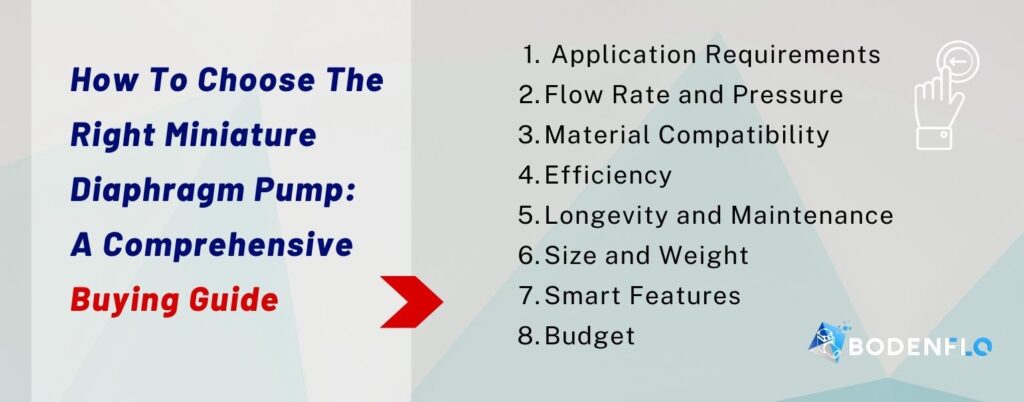
Selecting the right miniature diaphragm pump can be a daunting task, especially with the plethora of options available in the market today. To make an informed decision, consider the following key factors:
Application Requirements
The first step in choosing the right pump is understanding the specific requirements of your application. Are you moving air, gas, or perhaps corrosive substances? The type of material you are pumping will determine the compatibility requirements of the pump materials.
Flow Rate and Pressure
One of the primary considerations should be the desired flow rate and pressure. The pump you select should meet or exceed these requirements to ensure optimal performance.
Material Compatibility
Pay close attention to the materials used in the pump, especially for applications involving harsh or corrosive substances. Options like stainless steel, PTFE, or other corrosion-resistant materials may be more appropriate in such cases.
Efficiency
Operational efficiency is a critical factor that directly impacts your bottom line. Look for features like brushless DC motors or energy-efficient designs that consume less power without compromising performance.
Longevity and Maintenance
Consider the pump's expected lifespan and maintenance needs. Pumps with fewer moving parts and wear-resistant materials typically have longer service lives and lower maintenance costs.
Size and Weight
In applications where space is a premium, the dimensions of the pump are crucial. Make sure to measure the available space to ensure the pump will fit without obstructing other essential components.
Smart Features
Modern pumps often come with advanced features like IoT capabilities, variable speed control, and smart sensors. While these features might increase the initial cost, they often provide long-term benefits like ease of maintenance and better performance monitoring.
Budget
Last but not least, keep your budget in mind. While it may be tempting to go for the least expensive option, remember that a pump is an investment. Opt for quality and reliability, as these will pay off in the long run.
By carefully considering these factors and conducting thorough research, you can choose a miniature diaphragm pump that best suits your needs. Always consult with experts and consider running pilot tests whenever possible to ensure you are making the best possible choice.
Comparative Analysis: BODENFLO Pumps vs. Other Brand Pumps
The market for miniature diaphragm pumps is competitive, with several brands offering varying degrees of quality and efficiency. Among these, BODENFLO and Other Brand stand out as industry leaders. Although both brands have their merits, there are notable differences that can significantly influence your choice. Below, we take an in-depth look to compare BODENFLO pumps against Other Brand pumps, focusing on the aspects that truly matter.
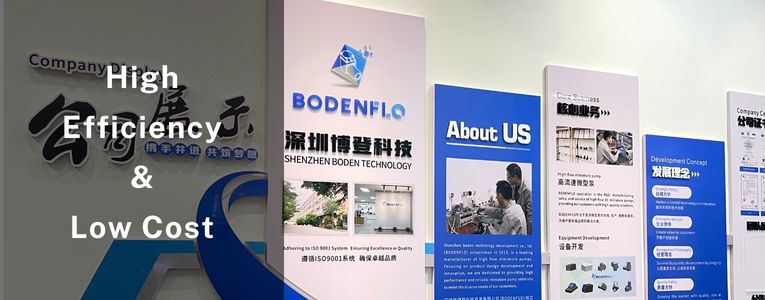
A. Material and Build Quality
BODENFLO Pumps: Crafted with state-of-the-art materials such as PPS for the pump head and EPDM for the diaphragm, BODENFLO pumps offer exceptional durability and corrosion resistance.
Other Brand Pumps: While Other Brand also offers high-quality construction, the range of material options may be more limited.
Verdict: If you require corrosion-resistant and durable pumps, BODENFLO comes out ahead with more material options.
B. Efficiency and Flow Rate
BODENFLO Pumps: Featuring advanced brushless DC motors, BODENFLO pumps deliver impressive efficiency with a maximum flow rate of 80 l/min.
Other Brand Pumps: Other Brand pumps generally offer solid efficiency, but their maximum flow rates may not reach the level of BODENFLO pumps.
Verdict: For higher efficiency and superior performance, BODENFLO holds the advantage.
C. Customization Options
BODENFLO Pumps: We pride ourselves on the ability to tailor our pumps according to specific customer requirements. This is especially beneficial for OEMs and businesses with unique needs.
Other Brand Pumps: While Other Brand does offer a range of models, they may not offer the same level of customization that BODENFLO does.
Verdict: For unique project requirements, BODENFLO offers greater flexibility and customization.
D. Technological Advancements
BODENFLO Pumps: With continuous innovation at its core, BODENFLO incorporates the latest technologies, such as IoT and AI capabilities, into its products.
Other Brand Pumps: While they offer modern features, Other Brand may lag behind in integrating the latest technological advancements.
Verdict: For future-proof solutions, BODENFLO stands as the more innovative choice.
E. Cost-Effectiveness
BODENFLO Pumps: One of the standout features of BODENFLO pumps is their affordability. Despite delivering performance on par with European and American brands, BODENFLO pumps come at a price point that is nearly half, making them a highly cost-effective option without compromising on quality.
Other Brand Pumps: While some may offer initial affordability, they might not match the performance-to-cost ratio that BODENFLO provides.
Verdict: For a balance of price and performance, BODENFLO undoubtedly offers the best value for your investment.
Summary
BODENFLO and Other Brand pumps are both strong contenders in the miniature diaphragm pump market. However, BODENFLO distinguishes itself in areas like material quality, customization, and technological innovation. When selecting a pump, it’s essential to consider these aspects in relation to your specific needs to make an informed choice.
Case Studies: Real-World Applications of Our Miniature Diaphragm Pumps
When evaluating the effectiveness of any product, real-world application scenarios can serve as compelling proof points. We're proud to showcase case studies that illustrate the exceptional performance and reliability of Our Miniature Diaphragm Pumps across various industries.
Medical Ventilators
In the field of healthcare, Our Pumps have been integral in medical ventilators used in ICU settings. The need for precision and reliability in such a critical application is non-negotiable. Our pumps delivered optimal air pressure consistently, contributing to successful patient outcomes. The FDA-approved materials used in the construction of our pumps also ensured that they met the highest safety standards.
Environmental Monitoring Systems
Our Pumps are employed in environmental air quality monitoring systems. These systems require consistent airflow for accurate readings. One municipal government reported a 20% increase in data accuracy and a 15% longer operational lifespan of the system after switching to Our Pumps, thereby reducing both maintenance costs and the frequency of replacements.
Laboratory Equipment
Our pumps have also found applications in various types of laboratory equipment, such as gas chromatographs. In a recent study by a leading research institution, the use of Our Pumps led to faster and more accurate measurements, thanks to their precise flow rate control. Our Pumps' low power consumption also contributed to more energy-efficient laboratory operations.
Industrial Gas Detection
In an industrial setting where leak detection is critical for safety, a Fortune 500 company employed Our Pumps in their gas detection systems. They reported that the robust design and high-quality materials of our pumps significantly reduced system downtime, thus ensuring continuous monitoring and enhancing safety measures.
Beverage Dispensers
Our Pumps are even used in commercial beverage dispensers where consistent flow rate is critical for drink quality. A renowned coffee chain reported an increase in customer satisfaction after implementing our pumps, attributing it to the consistent quality and temperature of the dispensed beverages.
By showcasing these real-world applications, we aim to emphasize not just the versatility of Our Pumps but also their dependability and high performance across a range of critical applications. These case studies serve as a testament to the value and quality that Our Pumps bring to the table.
Regulations and Compliance Standards
In a world where safety and quality are paramount, especially in critical industries like healthcare, environmental monitoring, and industrial safety, compliance with relevant regulations and standards is not just a necessity but a responsibility. We take this responsibility very seriously, and Our BODENFLO Miniature Diaphragm Pumps are engineered to meet the most stringent compliance standards.
ISO Certification
Our manufacturing facility is ISO 9001:2015 certified, which means we adhere to international standards for quality management. This certification underscores our commitment to providing high-quality pumps that meet or exceed customer expectations.
CE Marking
All of our pumps come with CE marking, signifying that they comply with European health, safety, and environmental protection standards. This makes it easier for our products to be sold in the European Economic Area (EEA) and ensures that they meet essential safety requirements.
RoHS Compliant
Our pumps are RoHS (Restriction of Hazardous Substances) compliant, meaning they are free from harmful materials like lead, cadmium, and mercury. This is particularly important for environmental monitoring systems and any other application where contamination could be an issue.
IP Ratings
Depending on the application, we offer pumps with different IP ratings to ensure durability and reliability in various environmental conditions, be it exposure to liquids or dust particles.
In summary, compliance isn't just a box we check; it is a foundational aspect of our product design and manufacturing processes. We recognize that in many applications, the margin for error is zero, and we engineer our pumps to operate within those strict parameters, giving our customers peace of mind.
Maintenance and Troubleshooting Tips
While our Miniature Diaphragm Pumps are designed for durability and long-lasting performance, regular maintenance is key to ensuring they operate at peak efficiency for extended periods. Whether you're a first-time user or a seasoned professional, our maintenance and troubleshooting tips aim to offer valuable guidance.
Routine Inspection
- Check for Debris: Periodically, remove the pump head and examine the diaphragm and valves for debris. Any obstruction can reduce efficiency.
- Inspect Seals and Gaskets: A weakened or broken seal can lead to leaks. Replace as necessary.
- Electrical Connections: Ensure all electrical connections are secure to prevent potential motor damage.
Cleaning and Lubrication
- Use Approved Cleaners: When cleaning the pump, use only manufacturer-recommended cleaning solutions.
- Lubrication: Some models may require periodic lubrication. Always refer to your user manual for specifics.
Troubleshooting Common Problems
- Reduced Flow Rate: This could be due to debris or a worn diaphragm. Inspect and replace components if necessary.
- Motor Not Running: Check electrical connections, fuses, and the motor. If the motor has burnt out, it will need replacement.
- Noise and Vibration: Excessive noise could be due to cavitation. Make sure the pump is primed properly. If the pump vibrates excessively, it may not be mounted securely or might be imbalanced.
Calibration and Testing
- Pressure Tests: Regularly perform pressure tests to ensure the pump is operating within prescribed limits.
- Flow Rate: Use a flow meter to measure and calibrate the flow rate, especially after replacing parts.
Expert Support
In case you encounter problems that are beyond basic troubleshooting, never hesitate to contact our technical support team. We also offer annual maintenance contracts for hassle-free, professional servicing of your pumps.
By following these tips, you can greatly extend the lifespan of your Miniature Diaphragm Pump and ensure it performs reliably. Rest assured that with proper care, our pumps are engineered to deliver consistent, high-quality results for your specific needs.
Frequently Asked Questions (FAQs)

In this section, we address some of the most commonly asked questions about miniature diaphragm pumps for air and gas applications. Our goal is to provide you with concise, expert answers to help you understand the fundamentals and capabilities of these specialized pumps.
1. What is a Miniature Diaphragm Pump?
A miniature diaphragm pump is a compact, high-efficiency pump that moves air or gas using a flexible diaphragm. The diaphragm oscillates, creating a vacuum that draws the fluid into the pump and then expels it out.
2. What are the Typical Applications for These Pumps?
Miniature diaphragm pumps are widely used in medical devices, analytical instruments, and HVAC systems. They are also found in environmental monitoring equipment, gas sampling, and various laboratory applications.
3. How Does Material Choice Affect Pump Performance?
The materials used for the diaphragm and other components can affect the pump's durability, chemical resistance, and overall lifespan. Materials like PTFE are ideal for corrosive or harsh environments, while EPDM is often used for general-purpose applications.
4. What Maintenance is Required?
Routine inspection, cleaning, and, in some cases, lubrication are essential. Always consult your user manual for specific maintenance guidelines.
5. What Do I Do if My Pump is Not Operating Properly?
First, refer to the troubleshooting tips provided in this article or your user manual. If the problem persists, contact technical support for advanced diagnosis and repair options.
6. Are These Pumps Compliant with Industry Standards?
Yes, our miniature diaphragm pumps are designed to meet or exceed relevant industry standards, including FDA regulations for medical devices, where applicable.
By being well-informed about the intricacies of miniature diaphragm pumps, you can make better choices for your specific needs and ensure that your pump operates effectively for years to come.
Conclusion
We hope this comprehensive guide has provided you with valuable insights into the world of miniature diaphragm pumps for air and gas applications. As we've explored, these pumps are integral components in a wide range of industries, including medical, analytical, and environmental sectors. Their compact design, high efficiency, and customizable features make them ideal for specialized tasks where space, reliability, and performance are critical.
The rapid advancements in pump technology, particularly in material science and control systems, are setting new benchmarks in durability and operational efficiency. By understanding the key features and benefits of these pumps, as highlighted in our comparative analysis, you can make an informed decision when selecting a pump that best meets your specific requirements.
If you have further questions or need more information, don't hesitate to consult the FAQ section or reach out to our technical support team. We also encourage you to look into the real-world case studies we presented, as they offer practical examples of how these pumps can solve specific challenges across various applications.
Thank you for taking the time to read this article. As the next steps, we recommend reviewing the buying guide and maintenance tips to equip yourself with the knowledge you need for a long-lasting, efficient pump system.
For more in-depth articles, resources, and product recommendations, be sure to check out our other publications or visit our product pages to explore the range of miniature diaphragm pumps we offer.
Your journey into the realm of high-efficiency, specialized pumping solutions starts here. Take action today to improve your operations and solve your pumping challenges.
Additional Resources and Further Reading

For those looking to dive deeper into the intricacies of miniature diaphragm pumps for air and gas, we've curated a list of additional resources that can further enhance your understanding:
Internal Links:
- Beginner's Guide to Pump Technology - A comprehensive guide for those new to the world of pumps.
- Troubleshooting Common Pump Issues - A handy guide to solve common problems with pumps.
- Our Product Range - Browse through our extensive range of miniature diaphragm pumps designed for different applications.
External Links:
- ISO Standards for Pump Manufacturing - An overview of the international standards for pumps.
- How Pumps Work - A Video Tutorial - A detailed video explaining the mechanics of different types of pumps.
- Recent Advances in Pump Technology - A scientific paper discussing the latest innovations in the pump industry.
Feel free to explore these resources to broaden your understanding and make more informed decisions for your specific pump needs.


